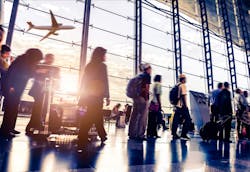The United States’ vaccine rollout has given many industries impacted by the pandemic a much-needed boost and the air travel industry is no different. In March 2021, airline passenger numbers reached the highest levels in over a year, topping 1.5 million. And on April 22, Transportation Security Administration (TSA) checkpoint data indicated an annual traveler throughput increase of 92 percent. After a full year refraining from travel to maintain social distancing guidelines during the pandemic, a newly-vaccinated public is ready to return to air travel and make up for lost time, leaving many industry analysts hopeful for a recovery – but this poses a critical question to airport leaders: Are their facilities ready to welcome passengers back safely?
To earn back public trust and protect the wellbeing of employees and passengers alike, airports need updated facilities that provide highly connected and data-driven environments. Studies show airports are ready to do just that; airports globally spent $3.5 billion on IT in 2020 and are projected to budget the same or more in 2021. By integrating powerful digital solutions, airport leaders can maximize non-aeronautical revenue opportunities, streamline the passenger experience and deliver safety and security at every touchpoint.
With a presence in more than 200 North American airports, Johnson Controls experts have witnessed first-hand how the COVID-19 pandemic has impacted the air travel industry. With travelers flooding back to airports this summer, now is the time to make the investment in a safer, more modern airport.
Proactive Security Tools Are Essential for Traveler Safety
As airports face new threats, from cyberattacks to viral pandemics, the time lost by relying on a purely reactive strategy can be disastrous. Fortunately, there are new technologies on the market that allow for proactive security. By integrating advanced digital solutions with artificial intelligence (AI) capabilities, security managers gain increased insight into all facility operations, allowing them to remain one step ahead of any safety risks.
As such, airports have seen soaring demand for identity management tools. Touchless access control leverages powerful but respectful facial recognition technology to provide security managers with advanced awareness of who is entering various zones of the airport. Facial recognition solutions can be easily integrated into existing video surveillance systems or as part of a self-service kiosk. In addition, 64 percent of airports plan to open self-boarding gates using biometric and identification documentation before 2030. By replacing physical passenger tickets with digital biometric technology, airports can strengthen security processes while streamlining traditionally hectic boarding processes to improve traveler experience. For further oversight, TSA associates can also reference heatmaps to monitor where crowds and bottlenecks are occurring, allowing them to quickly engage to disperse individuals before the situation escalates.
These proactive security solutions drive key outcomes. In addition to their impact on overall safety, they have other powerful benefits, including:
- Slowing the spread of viruses: Minimizing face-to-face human interaction is a key feature as airports work to limit the spread of disease. And by creating hands-free experiences, airports can mitigate the potential for surface contamination between passengers and employees.
- Reviving a key source of revenue: Proactive security can also have a positive effect on non-aeronautical revenue generation. The faster and more efficiently passengers can be processed, the more time they have to shop, dine and explore the terminals.
- Boosting sustainable practices: With technologies like advanced access control and a connected dashboard, airport managers can calibrate energy usage based on foot traffic and occupancy. Security leaders can integrate their building management systems with those of other airport operations executives, giving a full picture of energy usage and allowing for source optimization and forecasting.
By investing in proactive solutions, airports can strengthen their security processes and gain a heightened awareness of potential threats while creating a more enjoyable experience for their passengers – it’s a win-win.
Powerful analytics allow airports to expect the unexpected
Airports have long employed risk algorithms to remain prepared for unexpected emergencies. But as risk scenarios evolve over time, risk insight and active responder technologies must evolve accordingly. Leveraging digital twin technology, airport security managers can create a live digital replica environment by applying internal and external facility data. This enables security leaders to run innovative and highly accurate models and algorithms to account for the biggest risks facing their airport. These models ensure security managers are prepared for any scenario and can help guide them when designing their security systems. Digital twin technology can even help airports locate the source of costly, panic-inducing false alarms.
Analytics are quickly becoming a key component in how airport leaders can understand and best serve their customers. Using AI-powered data analytics, security managers can predict and understand passenger behaviors in the airport, and pattern recognition tools can automatically recognize and flag suspicious passenger activity to security personnel before the situation becomes dangerous. Additionally, by understanding the factors that most influence passengers’ shopping, dining and enjoyment, airports can redesign concourse layout for greater customer satisfaction and revenue generation while maintaining best-in-class security.
While data is a key component of any modern airport’s operations, it naturally leads to concerns around cybersecurity, especially as the public return to air travel after a long hiatus, resulting in a large influx of passenger data. With the right cybersecurity program, however, these vulnerabilities can be identified and eliminated. Currently, 83 percent of airports plan to implement a significant cybersecurity program, of which cyber-analysis is a key component. A trusted partner can work with airport leaders to identify gaps in their system and create a cybersecurity program aligned to their needs, allowing them to integrate new technologies without the concern of a cyberattack.
Creating a streamlined emergency response through integration
A surge in passengers can complicate airports’ emergency response processes; more passengers unfortunately create greater potential for accidents and violence, and also amount to more individuals that require evacuation. However, just as airports can implement proactive solutions to predict and analyze security threats, they can also install creative and integrated incident identification and response systems for a comprehensive, real-time emergency response. Whether the emergency involves fire, intrusion, gun violence, or simply suspicious behavior, security systems can be automated and connected to enable a streamlined and automated response.
By integrating security solutions onto a single network, multiple systems can communicate with each other for maximum efficiency. Mass notification systems (MNS), including text alerts, digital screens and kiosks, can be integrated with alarms to deliver evacuation guidance to passengers and employees. MNS can also instantly alert local first responders, providing them with detailed information about the situation so they can formulate a plan to best protect employees and travelers. Surveillance cameras can also be integrated with alarms to automatically lock and unlock entrances and exits based on the response required for the incident, preventing individuals from moving towards the danger.
In an emergency situation, every second counts. Through integration, airports’ emergency response processes are streamlined and automated, removing human error as a risk factor and ensuring an orderly evacuation process that can save lives.
Data-powered security is cleared for takeoff
In the wake of the COVID-19 pandemic, passengers who return to airports in the coming months will naturally have heightened expectations for airport security and efficiency. To assuage any concerns and earn back public trust, passengers will expect to see and experience a greater focus on their wellbeing and comfort, in addition to impenetrable security. Airports cannot afford to fall short.
By implementing the latest in advanced security solutions, airport leaders can create an enhanced environment that is data-powered and optimized for traveler wellness. From touchless access control to digital twin analytics, airports can welcome back travelers with a safe, healthy and enjoyable passenger experience that is even better than they remembered.
Ramsey Nuwar serves as Vertical Market Director, Transportation for Johnson Controls, the global leader for smart, healthy and sustainable buildings. Ramsey’s 30 years of experience have involved all aspects of the global aviation industry. During the last 12 years, he has focused primarily North American airports, providing leading passenger processing






